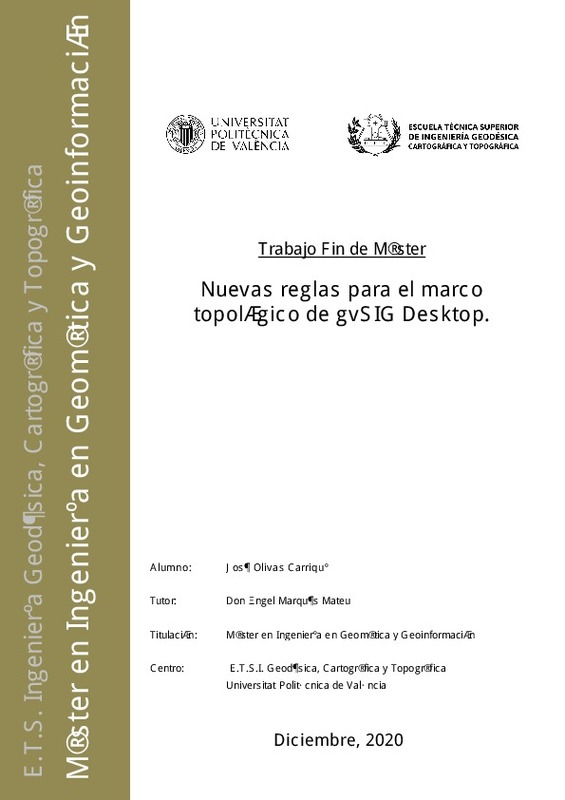|
Resumen:
|
[ES] El proyecto busca mejorar el marco topológico del software gvSIG Desktop. Para llevar a cabo lo anterior se corregirán algunas reglas ya desarrolladas y se implementaras otras desde cero.
Las reglas a modificar son ...[+]
[ES] El proyecto busca mejorar el marco topológico del software gvSIG Desktop. Para llevar a cabo lo anterior se corregirán algunas reglas ya desarrolladas y se implementaras otras desde cero.
Las reglas a modificar son "TopologyRuleMustBeProperlyInsidePolygonsPoint" y "TopologyRuleContainsPointPolygon". La primera evalúa la situación de los puntos con respecto a polígonos, si los puntos se encuentran en el interior de un polígono y no fuera o en el borde, la regla devuelve un valor positivo. La segunda regla comprueba polígonos, de modo que uno de esos polígonos será correcto si en su interior, no en el exterior o el borde, se encuentra uno o varios puntos. El motivo de su corrección es que en su estado actual no permite el tratamiento de algunos tipos de geometría (D2M, D3 y D3M) y multigeometrías.
Las nuevas reglas a desarrollar son tres; "TopologyRuleContainsOnePointPolygon", "TopologyRuleMustCoverEachOtherPolygon" y "UDR (TopologyRuleUserDefinedRule)".
La regla topológica "ContainsOnePoint" es muy parecida a "ContainsPointPolygon" con la salvedad que un polígono devuelve un resultado positivo si solo contiene un punto en su interior. La segunda regla a desarrollar, "MustCoverEachOther", busca que todos los polígonos del primer conjunto de datos queden contenidos por los polígonos del segundo conjunto de datos y viceversa. Por último la regla "UDR (TopologyRuleUserDefinedRule)" es un caso especial. Esta regla topológica es una regla comodín que permite al usuario implementar cualquier regla topológica desarrollada o no en el software, siempre y cuando el usuario sepa crear la expresión evaluadora. Su funcionamiento se resume en la utilización de esa expresión de evaluación definida por el usuario, la cual produce un valor booleano por caso. Si el valor es negativo ese caso genera una entrada en el reporte de errores. Si el resultado es positivo el proceso continua con el siguiente caso. Cuando el proceso de evaluación termina se aplicará sobre los casos detallados en el reporte de errores la acción correctora especificada por el usuario.
La implementación de esta última regla es más compleja ya que para su desarrollo hay que realizar cambios en el código fuente del marco de topología de gvSIG Desktop, creando y modificando métodos.
A parte de la implementación de las 5 reglas anteriores se desarrollarán diferentes acciones correctoras para cada regla. A parte de lo anterior, también se crea la documentación correspondiente tanto de la regla como de las posteriores acciones correctoras y se generan planes de prueba que garanticen el correcto funcionamiento de las reglas tras la implementación.
[-]
[EN] The project seeks to improve the topology engine of gvSIG Desktop, correct some topology rules and implant three new rules.
The topology rules to be modified are TopologyRuleMustBeProperlyInsidePolygonsPoint and ...[+]
[EN] The project seeks to improve the topology engine of gvSIG Desktop, correct some topology rules and implant three new rules.
The topology rules to be modified are TopologyRuleMustBeProperlyInsidePolygonsPoint and TopologyRuleContainsPointPolygon. In the first rule the points must fall within the polygon's area, not on the boundary or out of it. The second rule that to modify is very similar, each polygon must contain one or more points within the polygon's area, not on the boundary or out. This two rules have problems with the geometry type data (D2M, D3 and D3M) and the use of multigeometries. Also it is necessary to create new actions for cases when the rule outcome is false, update the documentation and create a test plan.
The new rules to be created are TopologyRuleContainsOnePointPolygon, TopologyRuleMustCoverEachOtherPolygon and UDR (TopologyRuleUserDefinedRule). In the first rule each polygon must contain only one point within the polygon's area, not on the boundary or out. The second rule seeks all polygons of dataset 1 and all the polygons of dataset 2 must cover each other. The contents to be created are the new rules themselves, their actions, documentation and test plans. UDR is a especial topology rule. This rule allows the user to define the parameters, check parameters and the formula to correct it. This statement can be used in all the topology rules created or not in the software. It depends on the knowledge of the necessary parameters. Basically, the features of a layer are evaluated for the checking parameters and it gives a boolean. If the result is False, the rule creates a entry in the error report. If the result is True, the process will continue with the next feature. When all features are evaluated, the rule checks the error report and does an action consisting of removing the feature or applying the corrective formula.
The implementation of this new rule is more complex than a normal topology rule and it is necessary to make changes in the topology core of gvSIG Desktop. Besides, new methods and class modifications to allow parameters in topology rules are also required which are completed with create a new documentation and test plan.
[-]
|







